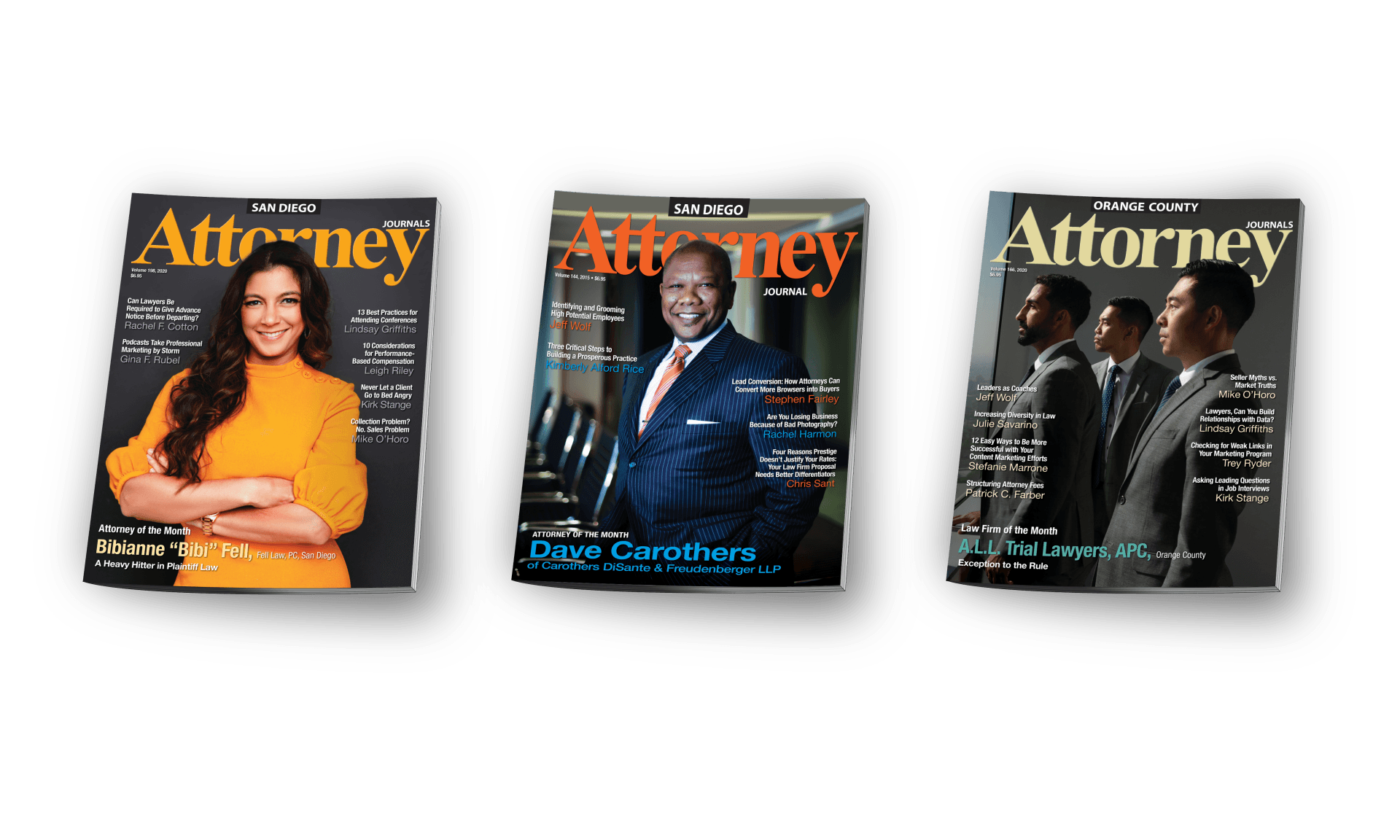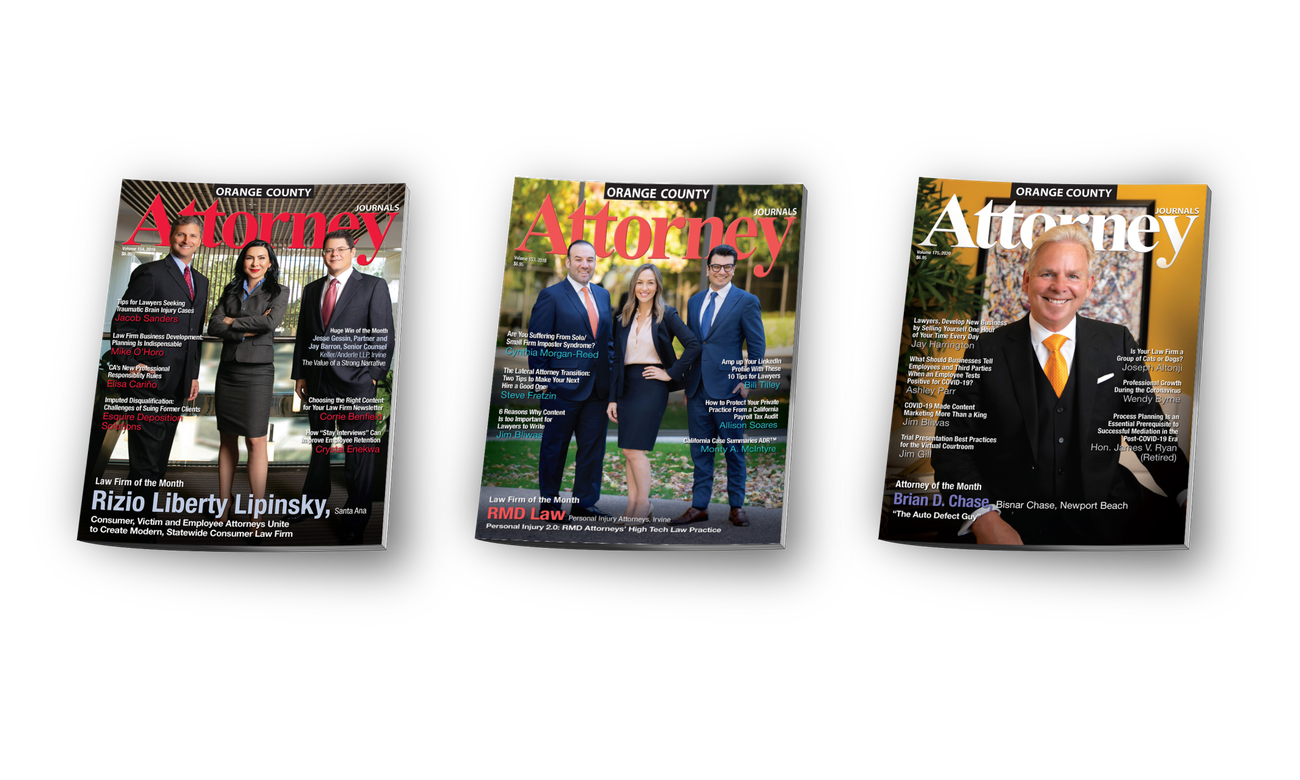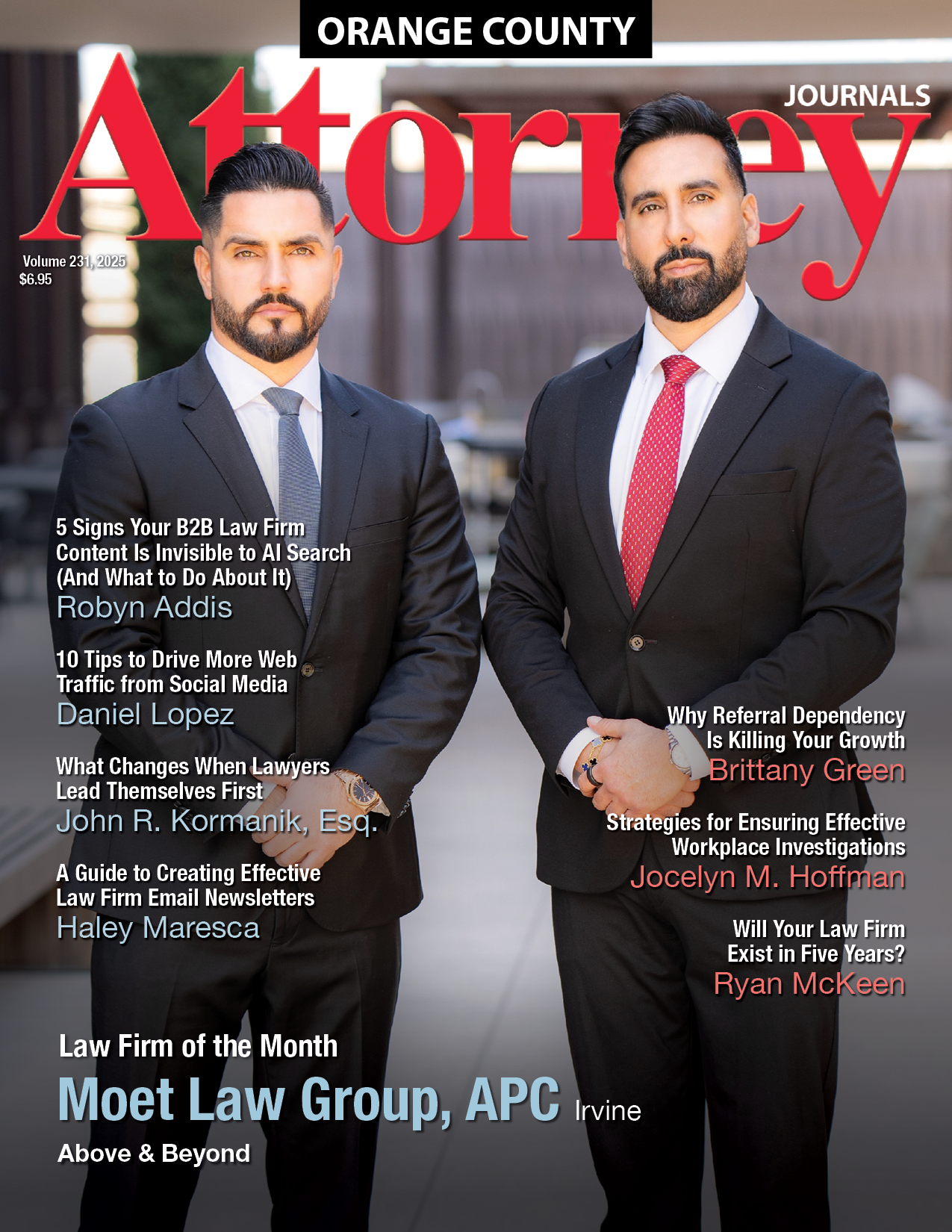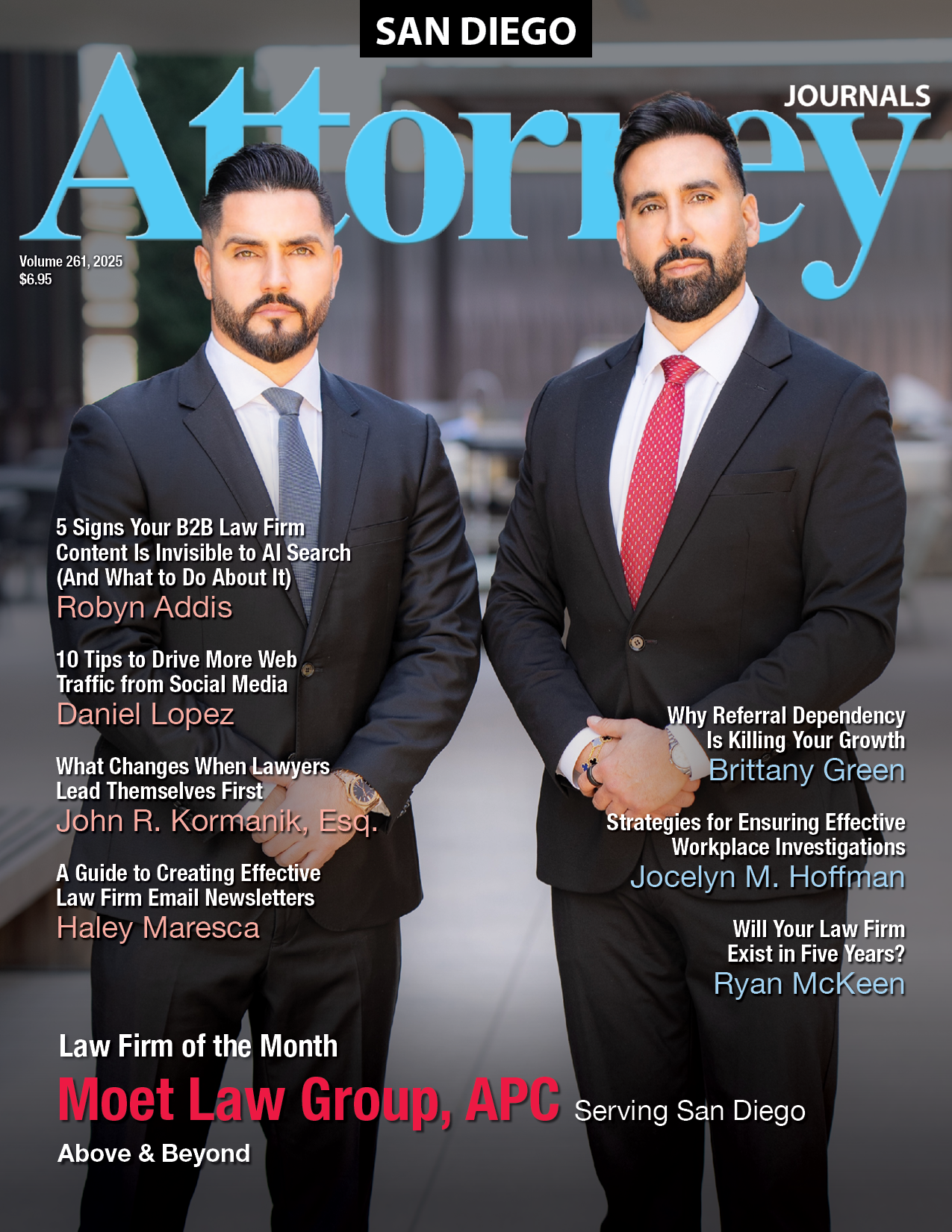Attorney Journals is a Southern California B2B trade publication for and about private practice attorneys. The magazine brings information and news to the legal community as well as providing a platform to spotlight the people, events and happenings of the industry. But that's not all. From marketing advice to business and personal development tips, we're the top resource you need to thrive in the ever-evolving and highly competitive legal industry.
The Latest Stories, Tips and Buzz!

The legal profession is standing at the edge of a radical transformation. Technology, shifting client expectations, new business models, and the accelerating pace of change are exposing a critical question: Will your law firm exist in five years? At Best Era, LLC, we consult with clients around the world and begin by asking them where they want to be in five years. If you aren’t thinking about five years from now, you should pause, and spend some time doing so. This isn’t just a rhetorical question. It’s one that demands sober, strategic reflection. The truth is that many firms won’t survive, not because they weren’t competent or profitable, but because they failed to adapt. If you’re leading a law firm, here are seven key questions that will determine whether you’ll still be in business half a decade from now. 1. Why Does Your Firm Exist? If you can’t answer this question clearly and persuasively, you’re already in trouble. Too many firms define their existence by inertia: We’ve always been here. Or circumstance: We signed a 10-year lease. Or comfort: We’re still making money. These are not reasons—they’re symptoms of complacency. A firm that wants to thrive must have: Well-defined values that serve as a compass in turbulent times. A clearly defined niche, because “we do everything” no longer works in a world of specialization and rapid information access. A value proposition that evolves, rooted in solving real problems in unique ways. If you don’t know why your firm exists beyond paying salaries and overhead, your future is up for grabs. The firms that will survive are mission-driven, nimble, and clear on their why. 2. Why Would Anyone Work for You? If your answer is “money,” you’re in serious danger. The legal workforce is shifting. Lawyers, especially younger ones, are increasingly driven by meaning, impact, lifestyle, and growth. Yes, they want to be paid fairly—but they also want: Purpose-driven work. Opportunities to innovate and lead. Work-life integration, not just work-life balance. Transparency and autonomy. In the age of remote work, digital tools, and widespread entrepreneurship, it’s never been easier for a talented lawyer to go solo. If your culture is built solely around compensation, you’ll find yourself in a constant cycle of turnover and talent drain. Firms that win in the next five years will create environments people want to be part of—because of how it feels, what it stands for, and what it enables. 3. Are You Hiring for the Skillsets of the Future? The skills that made a great lawyer in 2010 are not the same ones that will define success in 2030. Traditional legal education emphasized: Deep legal research. Meticulous writing. Adversarial thinking. Those skills still matter, but they’re no longer sufficient. Today, forward-thinking firms are hiring for: Project management expertise— because legal matters increasingly resemble complex operations. AI fluency— understanding how to prompt, audit, and collaborate with artificial intelligence tools. Client experience design— because value is judged not just by outcomes, but by process and communication. If your hiring is rooted in resumes and class ranks alone, you’re missing the moment. Firms of the future need people who can build, adapt, and lead in uncertainty. 4. How Strong Are Your Community Relationships? Law is a trust-based profession. And trust is built through proximity, consistency, and value. Firms that operate in a vacuum, rarely engaging with their community, industry, or niche—are out of touch and at risk. Ask yourself: Are we showing up where our clients and peers are? Are we listening to what they care about? Are we giving back in meaningful ways? Whether it’s through thought leadership, nonprofit partnerships, pro bono efforts, or local presence, community is your moat. Weak relationships mean weak referrals, poor retention, and diminished brand strength. 5. Is Your Business Model Built for a Post-Billable-Hour World? The “death of the billable hour” has been written about for decades. But today, it’s finally on life support. Why? Because AI, automation, and process optimization are collapsing the time it takes to deliver legal work. Tasks that used to take three days now take 30 minutes. If you’re billing by the hour, you’re incentivized to be slower, not smarter. Clients are noticing. The future belongs to firms that: Offer value-based pricing. Bundle services with subscriptions or flat fees. Use data and transparency to build trust, not mystery. If your margins depend on dragging out routine work, your model is in jeopardy. Start rethinking value, not as time spent, but as problems solved. 6. Are You Ready for a Leveled Playing Field? The tools of BigLaw are no longer exclusive. A solo practitioner armed with Westlaw AI, a decent case management system, and a smart strategy can now: Draft contracts at scale. File complex litigation. Deliver 24/7 client updates. This is a tectonic shift. Technology is democratizing legal services. You don’t need a floor of associates and paralegals to compete anymore—you need leverage and precision. This means: Rethinking your firm’s cost structure. Redesigning workflows for maximum automation. Competing on strategy and insight, not brute force. Legacy is no longer a moat. Agility is. 7. Can You Justify Working at Your Firm? Let’s say you’re a talented associate or even a partner. You’re watching AI eat time, remote work untethering geography, and legal entrepreneurs thriving with minimal overhead. Why stay? That’s the question your current and future lawyers are asking. If you want to retain and attract top talent, you’ll need answers like: “Because we offer growth and mentorship you can’t get elsewhere.” “Because our platform helps you scale your impact.” “Because we make it easy to do your best work without burning out.” Gone are the days when security and tradition were enough. Today’s legal professionals want alignment, innovation, and freedom. And if they don’t get it from you, they’ll go build it themselves. Conclusion: Five Years Is Closer Than You Think This isn’t alarmism—it’s realism. Law firms that thrive in the next five years will not be the biggest or the most prestigious. They will be: Mission-aligned. Tech-enabled. Client-centered. Talent-smart. If you’re not actively evolving in those directions, the clock is ticking. Start with the hard questions. Build from first principles. And above all, don’t assume you’re safe just because you’re profitable today. The winds have shifted. Make sure your sails are set.

Employers are often faced with complaints of harassment, discrimination, retaliation, and other kinds of misconduct. While no two investigations are identical, specific strategies exist to help conduct effective workplace investigations, which in turn helps build trust within the organization, lends a listening ear to aggrieved and accused employees and protects the organization from liability. This alert highlights strategies for ensuring that your workplace investigations promote organizational integrity, establish fair treatment, and foster a positive work environment. Identify the Scope Defining the scope of a workplace investigation is fundamental to its success and efficiency. A well-defined scope acts as a roadmap, preventing investigators from pursuing irrelevant leads while ensuring all pertinent issues are thoroughly examined. Without clear boundaries, investigations risk becoming unfocused fishing expeditions that waste resources, delay resolution, and potentially create additional liability. Investigators must identify the specific allegations and the relevant time period(s), parties involved, and evidence. They should also establish which policies are at issue and may have been violated. This framework helps maintain objectivity and ensures investigations remain focused on substantiating or disproving specific claims rather than expanding into tangential matters. Create Your Investigation Plan The moment a complaint is reported, the clock starts ticking. It is imperative to promptly investigate and to not unreasonably delay an investigation or to appear unresponsive to the allegations made. A timely investigation is critical to resolving and addressing any issues and to asserting possible defenses should the matter lead to litigation. While an effective investigation isn’t necessarily completed overnight, companies should consider timelines of one week, two weeks, or sometimes a month depending on the nature of the claims, the number of documents to review, and the number of interviewees involved. The investigator should come into each witness interview armed with an outline of questions to help guide the discussion. While the outline need not be followed rigidly, the outline can help the investigator stay organized, ensure key topics are covered, and help maintain a structured flow, ultimately leading to a more focused and successful interview. Additionally, the investigator should consider what the relevant documents are and ensure that all documents pertinent to the claims have been reviewed. For instance, does the investigator have access to relevant emails, text messages, complaints to human resources, disciplinary documents, and personnel files? Though it is not uncommon for new documents to be discovered during an interview, the investigator should enter the interview with a grasp of what the file entails. Last, when establishing a plan, choose a location where the interviewee will feel comfortable speaking frankly and truthfully. The environment of the interview can play a significant role in shaping the outcome of the interview. If the interviewee feels embarrassed, threatened, or spotlighted, the interviewee may not speak with full candor. To the extent possible, interviews should take place in a private room free from distractions or visibility to the interviewee’s colleagues. Off-site conference rooms or even remote interviews during which the interviewee is at home are encouraged. In some cases, it may be necessary to choose different locations for the various interviewees depending on the circumstances. In other words, a high-level manager with a secluded office may be interviewed in a different setting than an intern assigned to a cubicle alongside other colleagues. The investigator should also consider whether the individuals being interviewed are hourly employees who need to be compensated for the time spent participating in the investigation. Decide Whether Immediate Action is Necessary Businesses may be confronted with the issue of whether it is necessary to take immediate action after a complaint is reported. Depending on the nature of the complaint, taking immediate steps to protect the complainant may be critical. This may take the form of paid temporary leave, schedule adjustments, or physically separating the workspaces of the complainant and accused to prevent any further misconduct. Employers must be aware, however, that such decisions should not go so far as to burden or inconvenience the complainant and their ability to perform their job duties during the investigation. For example, placing the complainant on an unpaid suspension or transferring their work location without their consent can be perceived as retaliatory and is not recommended. Similarly, an employer must consider whether to remove the accused from the workplace pending investigation, temporarily reassign the accused to an alternative work assignment, and/or whether to compensate the accused if they are suspended pending investigation. Each investigation is unique and may warrant different circumstances during the pendency of an investigation. Communicate the “No Retaliation” Rule One of the most pressing considerations is ensuring that a workplace investigation does not result in retaliation. Every interviewee should be told at the outset that retaliation will not be tolerated against those who complain or those who participate in investigations. It must be made clear that acts of retaliation will be subject to disciplinary action, up to and including termination. Workplace investigations can place employees on the defensive, because they often feel like they are being accused of wrongdoing, even if they are not. This can lead to a sense of personal attack, fear of repercussions, and a desire to protect themselves by minimizing their involvement. Thus, communicating a “no retaliation” rule is critical in protecting the company and encouraging participation in the process. Employees should be instructed not to retaliate against anyone and should similarly be put on notice to report any retaliation they may face as a result of their own participation. Additionally, the investigator must explain that information provided during the interview may be shared with others only if absolutely necessary. Interviewees should understand that complete confidentiality cannot be guaranteed and may be virtually impossible to maintain in the event that a lawsuit arises. Should litigation be pursued, the interviewee should know that relevant parties will require copies of all statements and case-related documents. At the same time, the investigator can reassure the subject that they intend to uphold confidentiality as much as possible and that they plan to gather all available facts before reaching any conclusions. Choosing the Right Investigator One of the most avoidable hiccups is choosing the wrong investigator. The choice of investigator directly impacts the investigation’s credibility, effectiveness, and legal defensibility. Employers should pay heed to choosing an investigator with awareness and sensitivity. Differences in background, understanding, and experiences might affect communication styles, power dynamics, and interpretation of events. Remain Impartial Impartiality is key. The investigator should focus on maintaining a neutral and impartial tone throughout the course of the interview so as to not discredit impartiality or cause the interviewee to question their motives. While it may be tempting to gain the interviewee’s trust by acting like you are on their side, any flaws in the process can be used to challenge the credibility of the investigation’s findings, leading to potential legal liability for the employer. Reaching a Determination and Communicating to All Parties After conducting the initial interviews and any necessary follow-up interviews, there should be a formal conclusion to the investigation memorialized in writing. The final written report should reach an ultimate conclusion as to the facts and whether policies were violated, but should not opine on issues of law or use legal terms. The report should also highlight a section that provides a clear statement of the findings of the investigation on each key issue, including any issues that were not resolved. The final report should also include a list of the parties involved, employer policies or guidelines relevant to the investigation, and the parties responsible for making the final determination. The report should assess the credibility of witnesses. Did the interviewee display a clear sense of personal interest in the results of the investigation? Is the interviewee’s job on the line and would they have any reason to be untruthful? Does the interviewee have an obvious animus towards the complainant or accused? The investigator should be assessing the interviewee’s subjective credibility in ensuring whether their answers are truthful and accurate. The investigator may be tasked with issuing a recommendation on the employment decision, at which point a member of the business, in consultation with legal counsel, will assess, finalize, or reject that recommendation. If tasked with issuing the business a recommendation, the investigator should clearly identify the basis for their recommendation in an impartial manner, using the facts and information obtained during the course of the investigation. Last, effective communication is paramount when closing an investigation. An organization may want to consider the following approaches: providing appropriate notifications to involved parties while maintaining confidentiality, communicating outcomes to relevant stakeholders without disclosing sensitive details, ensuring transparency about the process and commitment to organizational standards, and offering support resources for employees affected by the investigation. Closing the Investigation Closing a workplace investigation is a delicate and crucial process that requires careful attention to detail, legal compliance, and organizational integrity. The manner in which an investigation is concluded can significantly impact employee trust, organizational culture, and potential future legal implications. Based on the investigation’s findings, the organization will want to develop a clear and actionable plan for resolution. This may include: Disciplinary actions for substantiated misconduct; Targeted training or educational interventions; Policy revisions or organizational practice improvements; Mediation or conflict resolution strategies for interpersonal issues. An investigation’s closure is not the end of the process, but a new beginning. Organizations should work to implement a follow-up plan to monitor the effectiveness of corrective actions, conduct periodic check-ins with the involved parties, track any recommended organizational changes, and assess the long-term impact of the investigation’s outcomes. By approaching the closure of a workplace investigation with thoroughness, empathy, and strategic insight, organizations can transform a potentially challenging situation into an opportunity for positive change and continuous improvement.

Email marketing can be a powerful means of bringing in new and repeat business for law firms. When executed properly, email marketing is a highly targeted and personalized strategy for firms to remain top of mind and build relationships with clients and prospects. Moreover, compared to other marketing channels, email marketing is an inexpensive way to share thought leadership content with an engaged audience. In this post, you’ll learn strategies that will help set your law firm’s newsletter up for success so that it can stand out among the barrage of emails flooding your subscribers’ inboxes. Elements of an Effective Law Firm Newsletter Valuable Content Unlike social media and other marketing efforts, your readers give you permission to send them an email. They’re already interested in what you have to say; now it’s your responsibility to provide them with valuable and educational content. Include snippets from recent blog posts with links back to the full article within your newsletter. If you’re not blogging (yet), that’s OK. You can write an occasional post on LinkedIn instead. Or, guest post on another blog. Include links to your posts and articles in the newsletter. You can also provide value to your clients by sharing reputable third-party content, such as links to law journals. Only curate from trusted sources that your readers may find useful. Lastly, be educational, not promotional. Promotional subject lines erode trust and may cause filters to block your emails. To avoid spam filters, look at this list of common spam trigger words and avoid using them in your subject lines. Repurposing from Your “Publications” Tab Many law firms have a “publications” tab on their website that lists practice area and topical alerts. Convert each into a newsletter or compile links to them in a monthly email. Ideally, these should be segmented. See more on segmentation and automation further below. Frequency is Consistent Shoot for weekly, but monthly is fine, also. It depends on your bandwidth and feedback from clients. Don’t create a weekly newsletter for your law firm if you don’t have the ability to get them out on schedule. There is no best time to send your email newsletter because it depends on your audience. There are certain days and times that are generally recommended, but to achieve optimal open rates and conversions you need to test! Studies show that 8:30am and 11am on Tuesday and Wednesdays are good email newsletter send days and times. Between 1-3pm is also recommended (MailChimp suggests 2pm). Use as a guide with an understanding that based on your target audience, other send days may work just as well or better. Test a few different days and times to see which gives you better results and then make that your go-to day and time for sending your emails. Consistency matters. Use Your Website as a Content Hub Your law firm’s website plays a critical role in the success of your email newsletter. Not only is it the central hub for the content you’ll share—like blogs, articles, attorney insights, or legal alerts—but it should also be optimized to capture new subscribers. Make sure your newsletter signup form is prominently placed on high-traffic pages such as your homepage, blog, and contact page. Include a compelling reason to subscribe, like receiving legal updates, practice-specific insights, or exclusive event invites. Additionally, your website should serve as a repository for past newsletters, webinars, and downloadable resources. Consider adding a dedicated “Insights” or “Resources” section where visitors can browse past content and opt-in to receive future updates via email. This reinforces your firm’s authority while increasing opportunities for conversion. Subject Lines are Engaging The general consensus is subject lines should be limited to 6 to 10 words or 60-70 characters. Desktop email displays about 60 characters and mobile about half of that. Enter your subject line at subjectline.com and you’ll get a score and some feedback on how to improve. Again, remember, these are guidelines. Rules are made to occasionally be broken. Don’t always try to manipulate copy to fit the perfect recommended size. More important than the length of your subject line, is that you put the most relevant information in the first 30-60 characters. Over time you’ll get a second sense about this. A Familiar Sender Name People are so inundated with SPAM emails, so they hesitate to open emails from unfamiliar senders. Make sure recipients can recognize you in their inbox by sending your law firm newsletter from a real person (marketing director, the firm managing partner, etc.). Emails from real people perform better in terms of open and click-through rate than emails sent from brands. Number of Links to Include We get asked this question frequently and there’s no easy answer. Our own anecdotal evidence shows decreasing click rates on links further down the email. Some studies have shown that 11 links may be a sweet spot. But if you only have three useful links to include in your newsletter, go for it. It’s not about the number of links but the quality of the information you link to. Include Only One Call to Action Remember that your email newsletter is educational rather than promotional. Each link is essentially a call to action, and you’re allowed one to your “services” page, but preferably, to an informational video, webinar or eBook. Banner ads work well here—your web designer can create one in Canva or Adobe InDesign. Choose the Right Email Platform Solos, small firms, and legal vendors have an exhaustive array of choices of email clients. We covered a few in: A Review of Email Marketing Platforms for Law Firms. Larger law firms have additional choices among enterprise-level email/marketing automation platforms including HubSpot, and Pardot. Emails Must be Mobile-Friendly More people today are scrolling through emails on their phone. All of the top email platforms include mobile-friendly versions. If you want to see how your email renders on different devices, check out Email on Acid or Litmus. Think mobile first when you create your newsletter in terms of how much content and graphics you include. Less is more. Growing Your Email List Your email list will decline over time due to unsubscribes or newly inactive email addresses. To keep your list growing you’ll need to invite people to sign up for your newsletter. You can do this several ways: Place an email subscription form in the footer or sidebar of your website. Create a lead magnet, such as an eBook or whitepaper related to each practice area and require an email to download. Remember to craft these pieces with the client’s problems in mind. Put on a quarterly webinar focused on the needs of the people you serve. An email address should be required to register for the webinar. Add a “resources” page to your website and put the webinar recordings there and require an email address to view. Encourage subscribers to share and forward your law firm’s emails by including social sharing buttons and an “email to a friend” button at the bottom of the email. Try encouraging those in your database that have unsubscribed to opt back in with an opt-in email campaign. Promote opt-in offers with paid ads on social media Automation and Segmentation Address your contacts with personalized content based on their online behavior. This is next-level email marketing. Don’t do this unless you have the bandwidth to create, monitor, and iterate. In a nutshell, segmentation lets you tailor an email campaign to a person’s specific interest. For an overview of this, see: Marketing Automation and Segmentation: How to Deliver the Right Content to the Right People at the Right Time. Measure Performance Track how your law firm email newsletters are doing so you know what’s working and what needs improvement. Email providers include metrics such as open and click rates. MailChimp provides good benchmarking resources, including the legal industry. According to their data, the average email open rate for legal services is 22% and the average click rate is 2.81%. If your click rate is low, maybe the content is not resonating with your audience. On the other hand, if your open rate is low try testing out some new subject lines. Takeaway Email marketing is an effective strategy for lawyers to provide value to current clients and nurture prospects to bring in new business. Law firm newsletters perform best when they are sent on a consistent basis and are inclusive of client-centric valuable content.

I almost didn’t show up. After a long international road trip, van trouble, and a disrupted routine, the temptation was real: skip the live presentation. Or mail it in. Just this once. But I didn’t. I showed up—because I made a promise. Not for the audience because, to be honest, depending on the platform, I sometimes don’t know if there are 1,000 people watching, or 0. The promise I made was to myself. I would show up and talk about something impactful, something that could change one person’s way of thinking and, just maybe, their life. I would show up and play full out. Since January 2023, I’ve shown up every month for a live presentation, whether people attend live or catch the replay. (As of today, that’s 29 live presentations.) This isn’t marketing. This isn’t lead generation. This is a commitment I made to myself: I will deliver one live presentation per month because it aligns with who I am, the work I do, and the promise I’ve made—to myself—for myself. And that’s what this post is about: the promises lawyers keep, and the one type of promise we too often break. Lawyers Are Excellent at Keeping Promises—to Everyone Else Let’s be clear: the lawyers I coach, those Accomplished Seekers, are some of the most disciplined professionals on the planet. They keep their promises. They wouldn’t be extraordinarily successful if they didn’t. To clients? Absolutely. You don’t miss deadlines. You show up in court. You meet your obligations. You do what you say you’ll do with the goal of serving the client and creating an evangelist for your firm. To partners? You don’t leave your colleagues hanging. They count on you and you count on them. Simple. To your team? You set expectations and follow through. You do what you say you’ll do and expect them to do the same. To judges and courts? You comply with the rules of the game—even when it’s chaos behind the scenes. To family? You try. There are seasons when you’re more available than others—like the 44-day federal white-collar trial I thrived in—but you do your best to follow through when you say “I’ll be there.” But there’s one person lawyers consistently betray—themselves. The Most Important Promises Are the Ones You Make—and Keep—for Yourself “I’m going to start eating better.” “I’m going to get to the gym three days a week.” “I’m going to stop checking email after 6 PM.” “I’m going to block time to think strategically about my firm.” You know these promises. You’ve made them. And chances are, you’ve broken a few. Maybe more than a few. Here’s why it matters: every time you make and break a promise to yourself, you erode trust—not with others, but with you. You move further away from the person you believe yourself to be. Instead, you move closer to what your internal voice continuously tells you you are, that someone who doesn’t deserve success and won’t do the work to create it. And that internal breach creates a dissonance that leaks into your energy, your mindset, and your leadership. It’s Not Time Management, It’s Energy Leadership Lawyers love to blame time: “I don’t have time to work out.” “I don’t have time to meditate.” “I don’t have time to think strategically.” Time, my friends, is not the problem. Time is indifferent. It’s agnostic. It doesn’t give a sh*t about your goals, your schedule, or your aspirations. Time doesn’t need managing. What needs mastering—what needs leading—is your energy. When I talk about Energy Leadership®, I’m referring to the seven levels of attitudinal energy that shape how we experience the world, how we lead, and how we perform. They range from the lowest level—victimhood—to the highest—pure creation and choice. Here’s how this applies to promise-keeping: Level 1 You skip your workout because “life is too hard right now.” Level 2 You resent even needing to think about it: “Why do I always have to push so hard?” Level 3 You rationalize: “It’s fine, I’ll get to it later.” Level 4 You think of your team, your clients, your family—everyone but you. Level 5 You begin to realize that keeping promises to yourself is a win-win. You benefit, and so does everyone around you. Level 6–7 You start showing up as the strategic CEO of your life and career, choosing how and when you bring energy to each domain. The problem isn’t your calendar. The problem is how you’re relating to the commitments you make to yourself. Self-Leadership Is the Key to Influence You can’t preach a culture of well-being, sustainability, or high performance if you don’t live it. Your words won’t matter—your actions will. If you say, “We honor deep work,” but you never protect your own focus time… If you say, “We take real vacations,” but you’re answering emails poolside in Maui or in the Sacred Valley of Peru… If you say, “I’m working on being more intentional,” but you never slow down long enough to reflect… Your people notice. As any parent will tell you: people hear what you say and they watch what you do. They believe what you do. If there’s a disconnect between what you say the culture is and you don’t “walk the talk,” your influence suffers. The paradox is this: when you start keeping promises to yourself, you not only build internal integrity—you elevate your external influence. The Benefits of Keeping the Promise (To You) When you consistently keep promises to yourself, four things happen: Your Confidence Grows You start to trust yourself more deeply. You stop relying on motivation and start building identity. “I’m the kind of person who keeps my promises”—even when no one’s watching. Your Integrity Realigns The disconnect between how you see yourself and how you behave dissolves. You begin acting in alignment with your values and vision. Your Influence Expands Your team, clients, and even your family start to follow your lead—not because of what you say, but because of how you live. Your Freedom Increases When you show up for yourself, you create space—for thinking, for health, for creativity, for growth. You step off the hamster wheel and into your role as a true CEO. So, What’s YOUR First Promise? What’s the one promise you’ll make today—for yourself? It doesn’t need to be grand. A salad. A 20-minute walk. A 15-minute strategic thinking block. The promise isn’t about scale—it’s about significance. It’s about sending a signal to yourself that you matter. That your leadership begins with you. A journey of a thousand miles starts with a single step because until you take that step, the journey cannot start. It only continues if you keep stepping. And you only keep stepping if you keep the promises you make to yourself for yourself. Final Thought Am I the type of person who keeps their promises? Yes? Good. Am I the type of person who keeps my promises to myself—for myself? That’s the question. Because when you start keeping those promises—when you lead yourself first, everything else follows.

When Taylor Swift couldn’t control her own music catalog, she didn’t just complain about the unfairness of it all. She re-recorded everything. Built her own empire. Took back control. Your law firm probably needs the same energy. Here’s the uncomfortable truth: If 90% of your clients come from referrals, you don’t own your reputation. Other people do. You’re building their influence while staying completely dependent on their goodwill. And that’s a business model with an expiration date. The Hidden Cost of Referral Dependency Picture this scenario: Your biggest referral source retires next month. Or gets upset about a case outcome. Or starts sending their overflow to a younger associate they want to mentor. What happens to your pipeline? This isn’t hypothetical. It’s happening to successful attorneys every day. Lawyers who built solid practices on the foundation of “word of mouth marketing” suddenly find themselves scrambling when those mouths stop talking about them. The solution isn’t to abandon referrals because they’re still valuable. The solution is to stop being held hostage by them. It’s Time for Your Firm’s Independence Era Here’s how to build a practice that you actually control, starting today. 1. Create Content That Showcases Your Actual Expertise Stop hiding behind “lawyers don’t self-promote” excuses. You’re not bragging. You’re educating. What this looks like: LinkedIn articles addressing common client questions in your practice area Speaking engagements at industry events where your ideal clients gather Newsletter content that positions you as the go-to expert, not just “another lawyer” C ommunity involvement where you’re visible as a thought leader The goal? When someone needs your type of legal help, your name comes to mind first; not because someone else mentioned you, but because they’ve seen your expertise directly. 2. Build Your Own Client Pipeline Referrals are wonderful. But they’re also unpredictable, uncontrollable, and unreliable for consistent growth. Here’s your diversification strategy: SEO-optimized website content that answers the questions your ideal clients are Googling Google Business Profile that positions you as the local expert (yes, even Big Law partners need these) Direct networking in the communities where your clients actually spend time Past client nurturing through regular check-ins and valuable content sharing 3. Own Your Narrative Before Someone Else Tells It When you rely solely on referrals, other people control your story. They decide how you’re positioned, what you’re known for, and whether you get the opportunity at all. Take back control: Define your niche clearly and communicate it consistently Share client success stories (with permission) that demonstrate your unique approach Position yourself proactively instead of waiting for others to recommend you Build relationships directly with your ideal client base But What If “Marketing Feels Too Salesy for Lawyers”? Let’s get something straight: This isn’t about becoming a marketing machine. It’s about professional sustainability. You’re not selling. You’re solving problems for people who need your help. You’re making it easier for the right clients to find the right expert. You. When you hide your expertise, you’re actually doing a disservice to potential clients who could benefit from your knowledge. The Strategic Advantage of Brand Independence Lawyers who control their own brand and client pipeline have something their referral-dependent colleagues don’t: options. Options to be selective about cases. Options to raise rates. Options to pivot practice areas. Options to weather economic downturns or industry changes. Most importantly, options to build the practice they actually want instead of accepting whatever referrals happen to come their way. Stop Building Someone Else’s Empire The lawyers who thrive in the next decade won’t just be the most competent ones in the room. They’ll be the most known ones. Not because they’re attention-seekers, but because they understood that expertise without visibility is just expensive hobby knowledge. So yes, keep nurturing those referral relationships. But also start building something that belongs entirely to you. Because when you control your own narrative, set your own standards, and build your own platform, everything changes. Your law firm’s independence era is waiting. Time to write your own success story. The Bottom Line People can’t hire experts they can’t find. And they can’t find you if you’re invisible behind someone else’s recommendation. Stop playing small. Start building your own empire. Because in 2025, owning your professional destiny isn’t just smart business. It’s survival.

Your corporate law firm’s website dominates Google for relevant terms like “securities litigation attorney,” but when a General Counsel asks AI for whistleblower guidance, your decades of expertise might as well be invisible. While you’ve (hopefully) been perfecting your keyword game for search engines, AI tools like ChatGPT, Claude, and Perplexity have quietly become the new research assistants for busy in-house counsel. 71% of respondents to a recent survey say they now use AI for initial guidance–meaning if your content isn’t AI-friendly, you’re invisible to your potential clients. The silver lining? Most corporate law firms are still fighting yesterday’s SEO war, which means savvy firms can capture the AI visibility advantage before the competition catches on. Here are five warning signs your content is stuck in the Y2K era, plus immediate fixes that’ll make AI tools your new business development partner. 1. Your Content Fails the “Executive Summary Test” When AI can’t parse your guidance, it’s as though you’re on mute during the most important client call of the year; your expertise is technically present but completely unheard. Try this reality check: Open ChatGPT and ask, “What are the key disclosure requirements for a public company considering an acquisition?” If the AI response doesn’t reference your M&A expertise or cite your insights, you’ve discovered why your phone isn’t ringing with net-new client inquiries. This happens because AI tools prioritize content that provides actionable guidance in discernible language. Your eloquent prose about “leveraging sophisticated transaction structures to maximize shareholder value” sounds impressive in client presentations, but it doesn’t help a CFO who needs to know which SEC forms to file by when. Solution: Lead with the answer, not the credentials. Transform “Our securities litigation practice has successfully defended Fortune 500 companies against complex enforcement actions” into “When the SEC issues a Wells notice, companies typically have 30 days to respond with a Wells submission. Here’s what that timeline looks like: Days 1-7: Assemble response team and gather key documents…” Focus on providing concise, clear answers that anyone can understand. Include specific regulatory citations, realistic timelines, and practical next steps. AI tools reward content that sounds like it came from a trusted advisor’s desk, not a marketing department’s campaign. 2. Your Practice Pages Read Like Pitch Decks, Not Guidance Documents AI tools skip the sales speak and hunt for substance that actually helps decision-makers. Your employment litigation page might hold an ideal rank position for “workplace harassment attorney,” but if it reads like a capability’s presentation, AI tools will treat it like expensive wallpaper. They’re searching for educational content that helps human resource directors and general counsel understand their actual options and obligations. Run this diagnostic on your core practice pages: Do you address specific business scenarios and practical outcomes? Is 80% of your content educational rather than promotional? Can a busy executive understand their realistic timeline and next steps after reading your page? Do you answer the “what happens if…” questions that keep general counsel up at night? Would your content actually help someone make a business decision, or does it just describe your credentials? If you’re wincing at any of these questions, you’re speaking fluent lawyer-marketing in a world that demands plain-English business guidance. Solution: Flip the content hierarchy. Lead with education, close with credentials. Replace “Our M&A team has closed over $50 billion in transactions across diverse industries” with “Due diligence for a typical mid-market acquisition takes time to accomplish the following milestones…” Give business leaders the roadmap first. They’ll hire you to navigate the complex terrain, but only after they understand where they’re headed. 3. You’re Missing the “Business Context” AI Craves AI can’t connect your legal experience to real-world business challenges. These tools excel at synthesizing comprehensive guidance that spans multiple business and legal considerations. But if your trademark content ignores brand strategy implications, or your employment litigation pages don’t address hybrid workplace concerns, you’re missing the interconnected thinking that makes busy executives bookmark your insights. Consider this scenario: when a startup CEO asks AI about protecting intellectual property, they’re not just asking about filing patents; they want to understand how IP strategy affects fundraising, competitive positioning, employee agreements, and exit planning. If your content treats these as isolated legal services rather than integrated business strategy, AI will find sources that connect the business dots. Solution: Create content ecosystems that mirror real business complexity. Your securities compliance content should naturally connect to corporate governance, executive compensation, and M&A disclosure requirements. Your employment litigation guidance should link to workplace policy development, executive transition planning, and regulatory compliance strategies. This isn’t just smart internal linking; it’s demonstrating that you understand how legal issues actually impact business operations, which is exactly what sophisticated clients expect from their outside counsel. 4. Your “Insights” Sections Are Thought Leadership Theater Most corporate law firms publish insights that, at best, read like academic papers designed to impress other lawyers rather than help business leaders solve actual problems. Or, worse, they’re just self-congratulatory lists of accolades and awards. “Evolving Jurisprudence in Delaware Chancery Court Appraisal Rights” might showcase your legal scholarship, but it won’t help a private equity principal who needs practical guidance on structuring deal protection. AI tools, however, are insight treasure hunters. They scan for content that directly addresses business challenges with specific, actionable guidance. Solution: Source content ideas from actual client conversations, industry challenges, and emerging business trends. Then structure insights that provide complete, implementable guidance. Replace “Recent Developments in Trade Secret Protection” with “5 Steps to Protect Trade Secrets When Employees Leave for Competitors.” Then deliver specifics: “When a key employee with access to confidential information gives notice, immediately: 1) Conduct exit interview focused on ongoing obligations, 2) Disable system access and retrieve company devices, 3) Send written reminder of non-disclosure and non-compete obligations…” Position these insights prominently and make them easily scannable. AI tools notice content hierarchy, and buried insights suggest buried relevance. 5. You Have No Clue How AI Currently Represents Your Firm Here’s the wake-up call that might sting: you probably monitor your Chambers rankings obsessively, but you have zero visibility into how AI tools currently position your firm. You’re optimizing for legal directory algorithms while tomorrow’s clients are already using AI to shortlist potential counsel. It’s time to see how you stack up against your competitors in AI results. Develop 20 questions that general counsel, compliance officers, and business executives would ask AI about your practice areas. Test them across ChatGPT, Claude and Perplexity. Document when and how your firm appears—or doesn’t. If you discover that AI consistently recommends competitors for complex securities work, or provides generic guidance where your experience should shine, you’ve identified exactly where to focus your content efforts–and to get the ball rolling as soon as possible. Solution: Implement systematic AI monitoring as part of your competitive intelligence. Track which types of business challenges generate citations of your firm versus competitors. This isn’t vanity monitoring. It’s strategic positioning for the AI-assisted decision-making era that’s already reshaping how corporate clients select and engage legal counsel. Your Next Steps The AI revolution is reshaping how sophisticated clients evaluate and engage counsel right now. While your competitors are still only optimizing for search keywords, you can optimize for business answers and practical guidance. Start with the Executive Summary Test on your three most important practice areas. Then audit your insights–that is, your legal alerts, blogs, and news content–for real-world applicability. These two changes alone can dramatically improve your AI visibility within weeks, positioning your firm as the obvious choice when AI tools field business-critical legal questions. The future of B2B legal marketing isn’t about gaming search algorithms, it’s about genuinely helping business leaders navigate complex legal landscapes with confidence. And isn’t that precisely why your clients pay premium rates for your counsel in the first place? Your expertise deserves to be discovered, whether clients search traditional legal directories or ask AI for strategic guidance. Time to make sure it is. n Robyn Addis oversees all revenue-generating functions at 9Sail.com, including sales, marketing, and client success, with a focus on accelerating growth and expanding 9Sail’s legal market presence. 9Sail is a boutique digital marketing agency focused on helping law firms grow through intelligent search-driven strategies. They specialize in traditional SEO, pay-per-click ads, local service ads, and a newer discipline called Generative Engine Optimization (GEO)—which ensures legal practices show up prominently in AI-powered search tools like ChatGPT, Perplexity, and Gemini. Learn more at 9Sail.com.












